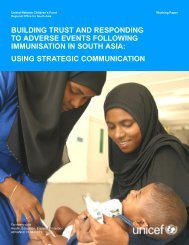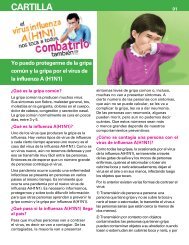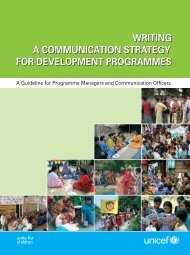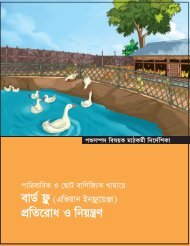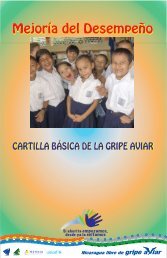<str<strong>on</strong>g>Joint</str<strong>on</strong>g> Writing Committeeintroducti<strong>on</strong>s in some areas and <strong>on</strong>going circul<strong>at</strong>i<strong>on</strong> in others)can be used to inform specific animal sector preventi<strong>on</strong>and c<strong>on</strong>trol measures. As well, d<strong>at</strong>a can be used to informpublic health risk assessment. For example, mut<strong>at</strong>i<strong>on</strong>s associ<strong>at</strong>edwith previous human pandemic isol<strong>at</strong>es have beenidentified in these viruses, and adamantane resistance hasalso been identified. These findings were communic<strong>at</strong>ed tothe intern<strong>at</strong>i<strong>on</strong>al public health sector immedi<strong>at</strong>ely afterdetermin<strong>at</strong>i<strong>on</strong>. Improved two-way communic<strong>at</strong>i<strong>on</strong> betweenthe animal and public health sectors regarding which specificmut<strong>at</strong>i<strong>on</strong>s are of public health interest, and which ofthose mut<strong>at</strong>i<strong>on</strong>s are circul<strong>at</strong>ing in animal popul<strong>at</strong>i<strong>on</strong>s,would optimize early detecti<strong>on</strong> of emerging viruses withincreased zo<strong>on</strong>otic or pandemic potential.The importance of system<strong>at</strong>ic m<strong>on</strong>itoring of AIVs forantiviral resistance was stressed. When current antiviralsare no l<strong>on</strong>ger useful against circul<strong>at</strong>ing strains, new antiviralsneed to be developed. Labor<strong>at</strong>ories need to investig<strong>at</strong>enew resistance mut<strong>at</strong>i<strong>on</strong>s by genotypic and phenotypicscreening, flag resistant viruses for tracking, and communic<strong>at</strong>ethese findings readily between the animal and publichealth sectors.Development of a standard H5N1 nomencl<strong>at</strong>ure by thejoint <str<strong>on</strong>g>WHO</str<strong>on</strong>g> ⁄ <str<strong>on</strong>g>OIE</str<strong>on</strong>g> ⁄ <str<strong>on</strong>g>FAO</str<strong>on</strong>g> H5N1 evoluti<strong>on</strong> working group hasprovided both the animal and public health sectors with aphylogenetic classific<strong>at</strong>i<strong>on</strong> system based <strong>on</strong> the HA gene. 5This system improves interpret<strong>at</strong>i<strong>on</strong> of sequence d<strong>at</strong>a fromdifferent labor<strong>at</strong>ories, removes subjective geographical references,allows for expansi<strong>on</strong> as new clades emerge, andprovides a basis for a more extensive system including antigenicvari<strong>at</strong>i<strong>on</strong> and genotyping. Expansi<strong>on</strong> of the system toH9 and SIVs is being planned. It was menti<strong>on</strong>ed th<strong>at</strong> theunified nomencl<strong>at</strong>ure further strengthens pandemic preparednessactivities rel<strong>at</strong>ed to vaccine, antiviral, and diagnostictest development and stockpiling by focusing efforts<strong>on</strong> the most relevant emerging viruses.5 http://www.who.int/csr/disease/avian_influenza/guidelines ⁄ nomencl<strong>at</strong>ure/en/index.htmlAntigenic cartographyAntigenic cartography provides a way to visualize the antigenicevoluti<strong>on</strong> of influenza viruses using HI assay d<strong>at</strong>a. Inantigenic maps, antigenically similar viruses appear closertogether, allowing visualiz<strong>at</strong>i<strong>on</strong> of antigenic changesthrough time and geographical space. The technique wasfirst applied to human H3 virus evoluti<strong>on</strong>, using ferretserumgener<strong>at</strong>ed HI d<strong>at</strong>a from human seas<strong>on</strong>al viruses, andsince 2004 has been effectively used by <str<strong>on</strong>g>WHO</str<strong>on</strong>g> for selecti<strong>on</strong>of human influenza vaccine strains. H5 antigenic cartographyis in the early stages of development for human vaccinestrain selecti<strong>on</strong>, but is also being used for evalu<strong>at</strong>ingavian viruses for animal health sector use. Different p<strong>at</strong>ternsare being seen using the animal health sector HI d<strong>at</strong>a,which may be due to cre<strong>at</strong>i<strong>on</strong> of HI sera in chickens(r<strong>at</strong>her than ferrets) or to using sera raised with adjuvanted(r<strong>at</strong>her than n<strong>on</strong>-adjuvanted) antigens. It was suggestedth<strong>at</strong>, ideally, the antigenic analyses of circul<strong>at</strong>ing strains bythe animal health and public health sectors should be integr<strong>at</strong>ed.Epidemiological and virological surveillance and inform<strong>at</strong>i<strong>on</strong>sharingIn discussi<strong>on</strong>, the importance of strengthening global virologicaland epidemiological surveillance for H5N1 and otheranimal influenza viruses to ensure early detecti<strong>on</strong> of bothdisease and virological changes was str<strong>on</strong>gly emphasized.It was agreed th<strong>at</strong> both the animal and public he<strong>at</strong>h sectorswould benefit from improved knowledge of the propertiesof H5N1 (or other AIVs) th<strong>at</strong> are circul<strong>at</strong>ing inanimals to adequ<strong>at</strong>ely assess which strains should be recommendedfor veterinary and human vaccines and toupd<strong>at</strong>e diagnostic reagents according to genetic and antigenicevoluti<strong>on</strong>. Having a full and broad picture of the distributi<strong>on</strong>and prevalence of viruses and disease globallywould allow better assessments of animal and public healthrisks, as well as the identific<strong>at</strong>i<strong>on</strong> of mut<strong>at</strong>i<strong>on</strong>s of publichealth significance.Surveillance in poultry and wild birds in Europe,North America, H<strong>on</strong>g K<strong>on</strong>g, and other selected loc<strong>at</strong>i<strong>on</strong>sis intensive, but in many areas of AI risk, surveillance isweak or lacking and needs to be supported andimproved in a sustainable way. It was noted th<strong>at</strong> inEurope, existing surveillance has led to early detecti<strong>on</strong> ofH5N1 <strong>on</strong> several occasi<strong>on</strong>s. Currently, the extensiveEuropean d<strong>at</strong>a is maintained in the DG-SANCO d<strong>at</strong>abase,6 and partly (for wild bird isol<strong>at</strong>es) in theEU-funded research project New-Flubird. 7 A comm<strong>on</strong>global pl<strong>at</strong>form and linking of surveillance systems wouldbe ideal, with <strong>on</strong>e c<strong>on</strong>straint being the differences intypes of surveillance am<strong>on</strong>g countries. Improved communic<strong>at</strong>i<strong>on</strong>between existing pl<strong>at</strong>forms would already be apositive step forward.It was recognized th<strong>at</strong> when effective passive and activesurveillance leads to early disease detecti<strong>on</strong>, then diseasec<strong>on</strong>trol is improved. However, effective animal sector surveillancerequires a complete and functi<strong>on</strong>al veterinaryinfrastructure and supporting diagnostic labor<strong>at</strong>ory capacity.As well, effective use of resources requires appropri<strong>at</strong>etargeting (e.g., by species, sector) and implement<strong>at</strong>i<strong>on</strong>according to differing disease p<strong>at</strong>terns (e.g., for sporadicversus endemic disease situ<strong>at</strong>i<strong>on</strong>s). It was recognized th<strong>at</strong>6 DG Sanco d<strong>at</strong>a available <strong>at</strong> http://ec.europa.eu/food/animal/diseases/c<strong>on</strong>trolmeasures/avian/eu_resp_surveillance_en.htm7 New Flubird d<strong>at</strong>a available <strong>at</strong> http: ⁄⁄www.new-flubird.eu ⁄8 ª 2010 <str<strong>on</strong>g>FAO</str<strong>on</strong>g>, <str<strong>on</strong>g>OIE</str<strong>on</strong>g> and <str<strong>on</strong>g>WHO</str<strong>on</strong>g>, <strong>Influenza</strong> and Other Respir<strong>at</strong>ory Viruses, 4 (Suppl. 1), 1–29
<str<strong>on</strong>g>FAO</str<strong>on</strong>g>-<str<strong>on</strong>g>OIE</str<strong>on</strong>g>-<str<strong>on</strong>g>WHO</str<strong>on</strong>g> <str<strong>on</strong>g>Joint</str<strong>on</strong>g> <str<strong>on</strong>g>Technical</str<strong>on</strong>g> <str<strong>on</strong>g>C<strong>on</strong>sult<strong>at</strong>i<strong>on</strong></str<strong>on</strong>g> <strong>on</strong> <strong>Avian</strong> <strong>Influenza</strong> <strong>at</strong> the Human-Animal Interfacesurveillance may not be implemented properly, even if thesystem is appropri<strong>at</strong>ely written in the n<strong>at</strong>i<strong>on</strong>al legisl<strong>at</strong>i<strong>on</strong>.Surveillance systems in humans should also vary by the diseasesitu<strong>at</strong>i<strong>on</strong>. For example, where AIVs are endemic andsporadic human cases are occurring, it was suggested th<strong>at</strong>it would be most efficient to focus <strong>on</strong> the early identific<strong>at</strong>i<strong>on</strong>of clusters of human cases.The social aspects of surveillance were discussed, forexample th<strong>at</strong> passive surveillance fails when people feelthre<strong>at</strong>ened by the c<strong>on</strong>sequences or when tools and systemsare impractical for the targeted community (e.g., broadcase definiti<strong>on</strong>s for AI in areas where poultry de<strong>at</strong>hs arecomm<strong>on</strong>), and thus, th<strong>at</strong> surveillance should be community-basedand customized for each setting. The use ofcommunity-level incentives and disincentives was discussed,and it was agreed th<strong>at</strong> the differences between wh<strong>at</strong> may byc<strong>on</strong>sidered incentives and disincentives by the key playersin the human and animal health sectors may not be appreci<strong>at</strong>ed.It was agreed th<strong>at</strong> overall, surveillance in human andanimal popul<strong>at</strong>i<strong>on</strong>s should be better coordin<strong>at</strong>ed. Coordin<strong>at</strong>i<strong>on</strong>is working well in Ind<strong>on</strong>esia, where there is activehuman surveillance in areas of animal outbreaks and viceversa. This has, for example, reduced average time tohuman antiviral tre<strong>at</strong>ment from 4 to 2 days. It was suggestedth<strong>at</strong> it would be more sustainable to coordin<strong>at</strong>e AIsurveillance with surveillance for other zo<strong>on</strong>otic diseases.It was agreed th<strong>at</strong> any coordin<strong>at</strong>i<strong>on</strong> requires good communic<strong>at</strong>i<strong>on</strong>between the animal and public health sectors,which may vary <strong>on</strong> the local level and may be influencedpolitically.There was a generalized call for <str<strong>on</strong>g>OIE</str<strong>on</strong>g>, <str<strong>on</strong>g>FAO</str<strong>on</strong>g>, and <str<strong>on</strong>g>WHO</str<strong>on</strong>g>to formalize the sharing of virus samples and associ<strong>at</strong>edinform<strong>at</strong>i<strong>on</strong> for all AIVs. The importance of whole genomesequencing of an appropri<strong>at</strong>e virus subset and ensuringtimely availability of inform<strong>at</strong>i<strong>on</strong> was also stressed.The problem of inform<strong>at</strong>i<strong>on</strong> sharing with and am<strong>on</strong>gcountries who may have technological difficulties in ‘‘c<strong>on</strong>necting’’was discussed (as these are often the countries <strong>at</strong>risk). It was noted th<strong>at</strong> timely inform<strong>at</strong>i<strong>on</strong> sharing canalso allow individual countries to decrease their risk ofexposure.4 Human transmissi<strong>on</strong> risks and exposuresource (Sessi<strong>on</strong> 3)The objective of sessi<strong>on</strong> three was to identify likely modesof transmissi<strong>on</strong> and exposure sources for zo<strong>on</strong>otic infecti<strong>on</strong>with AIVs. During this sessi<strong>on</strong>, speakers presented d<strong>at</strong>a <strong>on</strong>possible modes of seas<strong>on</strong>al and zo<strong>on</strong>otic influenza transmissi<strong>on</strong>;sources of exposure for human cases of H5N1(including the potential roles of exposure to poultry productsand by-products, of culturally relevant poultry ⁄ humaninteracti<strong>on</strong>s, of poultry management systems, of LBMs andof c<strong>on</strong>tamin<strong>at</strong>ed envir<strong>on</strong>ments); food safety issues; andevidence to explain the low incidence of H5N1 cases inhumans. The country represent<strong>at</strong>ives briefly outlined wh<strong>at</strong>they c<strong>on</strong>sidered the successes and challenges of theirn<strong>at</strong>i<strong>on</strong>al H5N1 experience, which are also summarizedhere.4.1 Modes of transmissi<strong>on</strong> for human infecti<strong>on</strong>with avian influenza virusesModes of transmissi<strong>on</strong>The modes of human seas<strong>on</strong>al influenza transmissi<strong>on</strong> havenot been completely elucid<strong>at</strong>ed. People shed influenza virusfrom the respir<strong>at</strong>ory tract, and potential modes of transmissi<strong>on</strong>include c<strong>on</strong>tact spread, aerosol spread, and dropletexposure. <strong>Influenza</strong> virus survives <strong>on</strong> hands for 5 minutesbut <strong>on</strong> other surfaces for 12–48 hours. It was suggestedth<strong>at</strong> hand hygiene is important to decreasing risk. Viabilityof virus in aerosols depends <strong>on</strong> initial c<strong>on</strong>centr<strong>at</strong>i<strong>on</strong>, temper<strong>at</strong>ure,and humidity. Inhalable particles account for





